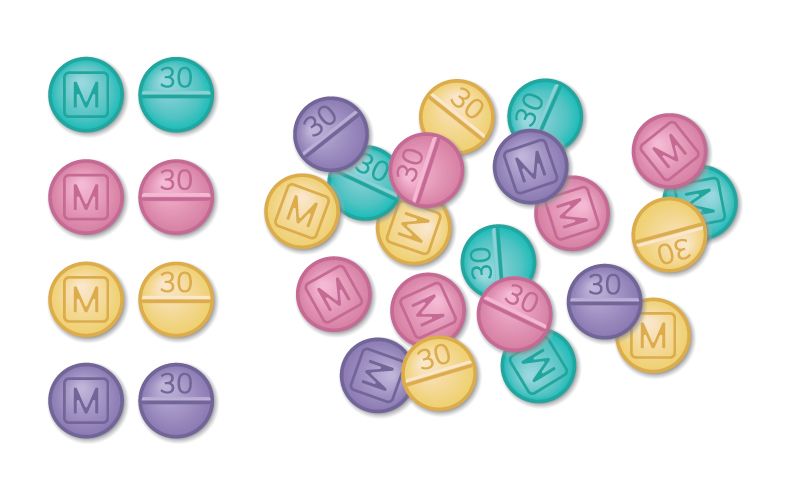The Fentanyl, P2P, and Meth Double Menace: Powerful Synthetic Drugs Impacts on the Economy, Rise in Homelessness and Youth Fatalities
The massive availability and use of powerful synthetic drugs like Fentanyl, the most powerful drug known to man, and new more potent versions of Meth, like P2P, are causing a growing problem in the United States. Both drugs are now available “coast to coast” like never before. Overdose deaths rose during the COVID-19 pandemic, and in 2021, more than 100,000 people died in the U.S. of drug overdoses. About 71,000 of those deaths were related to synthetic opioids, according to the CDC.
Children and teens who ingest fake prescription pills and tiny candies laced with Fentanyl are becoming seriously ill or dying every week in America. Meanwhile P2P, a very easily produced type of Meth, is ravaging the streets of the United States, and increasing addiction, severe mental health issues, and homelessness.

At a briefing by Ethnic Media Services, Dec. 10, speakers – Sam Quinones, journalist, storyteller, former LA Times reporter, and author of four acclaimed books of narrative nonfiction. His most recent book is ‘The Least of Us: True Tales of America and Hope in the Time of Fentanyl and Meth,’ released in 2021; and John, an ER Doctor from a major western city (he has agreed to speak on condition of anonymity) – briefed media on their findings.
“When I first started in Chicago, overwhelmingly the use that we’d see there was all Heroin, all almost exclusively Heroin, and I was in a critical access County hospital. The the drug use that we’d see there was very little Methamphetamine, much more Heroin, and then as my time there continued, we started seeing Fentanyl,” said John.
“We’d see Fentanyl in the context of accidental overdoses. My last year in Chicago, about 2016-2017, we would start seeing these accidental overdoses with Fentanyl and then obviously in Chicago we saw all the deaths that were secondary to the violence related to the Heroin trade there and the drug trade there as we were the major trauma center in Chicago.
“Once I moved back to the West Coast, there were geographical differences. I went to medical school in Oregon and there were more Methamphetamine, just on the West Coast in general.
“What we saw for the opiate side of things is there was a decrease in opiate use when I first came back and I believe that was likely from states cracking down on unnecessary prescriptions. They started cracking down on oxycodone prescriptions and I think there’s a lot of education surrounding it, but then in 2019-2020 we started seeing an increase in opiate use disorder. Probably, the pandemic had something to do with it.
“It started with Heroin and then we’d start seeing these accidental overdoses again where they tried to do Heroin, but they accidentally did Fentanyl.
“What we’re seeing now is exclusively people using Fentanyl on purpose,” said John.
“We’ve had overdose deaths with pills that looks like an OxyContin oxycodone pill and kids take it, and they overdose on that.
“And because Fentanyl easily aerosolizes, when officers arrest somebody and they’re going through their belongings and trying to figure out if there’s a white powder, they open the bag, and that bag easily aerosolizes, leading to overdoses of Fentanyl for officers and first responders.
“It’s important to know that Heroin and Morphine, Oxycodone, Norco, your typical opiates before Fentanyl are dosed in milligrams, whereas Fentanyl is just in micrograms. Fentanyl is a medication we frequently use, and it’s been around for a while. It’s very quick on and quick off.
“One of the problems with Fentanyl is that since it’s dosed in micrograms, it’s a hundred times more powerful or potent if you give that milligram dose.
“People who use Heroin, would use the amount of Heroin they use. If it was Fentanyl, they would have immediately overdosed.
“The dosage is much smaller for Fentanyl. It’s quick on quick off. When people get Fentanyl, they’ll be high for a very short amount of time or their pain will be treated for a very short amount of time, and then they’ll have pain again.
“One of the reasons we use it in the Emergency department or in EMS is because that property makes it hemodynamically stable.
“When a trauma patient comes in, who has low blood pressure because they’re bleeding, Fentanyl is a way to help treat their pain deeply without dropping their pressure or affecting their pressure. It’s quick on quick off means that it’s for us since we’re using such lower doses it’s harder to get into trouble with stacking the dose on top of each other.
“But on the street, since it’s dosed in such a small amount it’s very hard for people to use it in a way that is safe.
“From 2018 on we’re seeing more psychosis with methamphetamine,” said John.
“I would say that Fentanyl is an opioid. It’s a depressant. It’s used in surgery since 1960 when it was developed,” said Quinones.
“I’ve had fentanyl in a surgical setting when I had a heart attack. It’s a wonderful drug. It does all that John was talking about and gets you in and out, and it allows for the kinds of surgery that you can never do pre-Fentanyl.
“Fentanyl now being produced by the Mexican drug trafficking world in staggering quantities, as is Methamphetamine. We’re now in the synthetic drug era. Traffickers in Mexico have basically transitioned away from plant drugs largely towards drugs that can be made in a lab with only chemicals, and the main two are Fentanyl and Methamphetamine.
“The method they’re using now allows them to make it far more pure, far more potent, and so what you’re seeing now is that Meth and Fentanyl have really covered the entire United States. This has never happened before where one source, the Mexican Trafficking World, in this case, has covered the entire country from LA to Maine with not one, but two of these very potent and devastating drugs.
“These two drugs, primarily Meth, seems to be a major driver in mental illness, also leading to homelessness, leading to people in tent encampments, which are now the new form homelessness takes across America. Encampments didn’t exist 10 years ago in my view, the way they do today.
“What’s also stunning about both drugs is that they leave the user absolutely terrified of not having access to the drugs. So people will stay in tents even though they’re offered housing or treatment, even though the temperature is dropped to very lethal levels, even though snowing.
“It is in such contrast with opiate use disorder where opiate users understand that there’s a problem; they understand that it’s an addiction, but they say ‘Look, I get drug sick. I feel terrible,’ they’ll acknowledge that for whatever reason. Methamphetamine users have a very difficult time acknowledging that, and part of that is because they’re in a state of psychosis. They’re seeing spiders come out of the walls; they’re seeing things that are terrifying to them; and they come to us and we say, ‘It’s probably the Methamphetamine that’s causing this because you’re normal before you started using this,’ but they cannot acknowledge that for whatever reason,” said John.
“Before the supplies that came out of Mexico, there used to be small scale Meth cooks in various parts of the country and those have been run out of business by this very cheap very potent stuff coming out of Mexico,” said Quinones.
“All the Fentanyl produced in Mexico is trafficked North by larger cartels and many other smaller trafficking organizations and families that make up the Mexican drug trafficking ecosystem.
“It’s vast, involving lots of people, most of that comes across the Border in trucks, or cars, some of it comes across strapped to people’s bodies or in canes, backpacks.
“But really, you’re talking about quantities that couldn’t possibly be achievable using people’s backpacks, kilos of the stuff.
“In the last few years, we have also seen the Mexican trafficking world transition pivot in about 2017 towards packaging Fentanyl a new way and that was in counterfeit, phony pills that look like legitimate pharmaceuticals.
“The first example was Oxycodone, the blue Oxycodone generics 30 milligram pill that was made back then with ‘M’ for Mallinckrodt, the company that made it. We began to see that being counterfeited. The legitimate pill had Oxycodone, and the counterfeits pills have only Fentanyl, being produced by the millions.
“There’s also a counterfeit Adderall; counterfeit Xanax, counterfeit Percocet; counterfeit Tylenol.
“What we are finding now are pills in multi-colored form. They’re supposed to look like the press blue, but they’re red, yellow, and green. On the streets, people are addicted to Fentanyl and they don’t care what Fentanyl pills look like, only that they get their Fentanyl.
“These pills are being sold frequently on social media apps like Snapchat primarily. I went to a Snapchat protest in Santa Monica, Calif., a year ago in June 2021, where families who had lost their kids who had bought pills on Snapchat, were protesting and they had big posters saying ‘Snapchat is complicit in my son’s murder.’ A lot of this took place during COVID because the kids couldn’t leave the house. The only way they connected to the world was through their phones and people were anonymously selling drugs with very colorful menus that looked like an ice cream truck menu,” said Quinones.
“These people are probably not much older than the people they’re selling to. In LA, there was an offer to deliver the pills to the person, the kid’s house, so you’re seeing the social media app become like the new street corner,” said Quinones.
“The supplies of these drugs are being made in in catastrophic quantities,” said Quinones.
“Fentanyl, though it’s much more potent, it is an opiate, so opiate treatment programs do work for this. In overdose, you can give Narcan, that reverses the effects immediately, of an opiate. “The effects that kill you from Fentanyl is, it causes severe respiratory depression, meaning you stop breathing. Heroin, Morphine, Norco Oxycodone, have severe risk before depression and they stop breathing.
“Fentanyl, since it’s so much more potent, the condition happens much more frequently. Narcan reverses that effect, and it works for about 45 minutes. Sometimes, you need to redose, depending on how much of a certain drug or a certain opiate they have in their system.
“But Narcan causes immediate withdrawal, as well as withdrawal symptoms like diarrhea, sweating, getting pain everywhere, just feeling like absolute garbage, nausea, vomiting, all those things.
“Narcan does not treat the addiction itself. The addiction is a physiologic change that’s happened in your body and what happens with addiction is that your body is used to that Fentanyl, it’s used to soaking these receptors called MU receptors in opiates, and when those opiates are gone, the body says, ‘where are the opiates?’ The body’s always looking for homeostasis and so there’s no opiates there and your body needs more opiates to satisfy that and so people get sick, and they start looking for more opiates.
“Methadone is a common treatment for this, but that has been rapidly replaced by another drug called Buprenorphine, a drug that is a partial agonist of that MU receptor. It works very well. If you try to use another opiate, it blocks it. So if you try to use Fentanyl, when you’re on Buprenorphine, it won’t be as effective. It won’t give you a high,” explained John.
“In the ER, we can treat opiate addiction, opiate overdose, we have a very effective protein. Another name for it is Suboxone, the trade name.
“Methamphetamine is considerably more difficult. There’s no treatment for Methamphetamine addiction, other than stop using.
“The biggest thing is if there are any narcotics in the house, if Mom or Dad is on a pain medication chronically or gets a pain medication because they broke their arm, that needs to be locked away.
“Try to monitor your kid’s social media, if you can,” suggested John.


